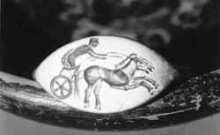This wonderful piece of jewelry from the fifth century BC has been proclaimed the No. 1 archeological find in Ukraine in the first year of the third millennium. The gold signet ring was created by a Greek, likely Milesian, master and dates back approximately to the fifth century before Christ. Although it is a large masculine signet ring, the refined outlines of the charioteer and his charger along with the dynamism of the whole picture show the high standard of workmanship of ancient jewelers.
We could begin to tell the story of this unique find by trying to solve a riddle: what do this ancient Greek bauble and a Bentley, Porsche, or Ferrari sports car have in common? There are two answers. The first common feature is that the chariot on the ring is also a sports vehicle. In other words, this was a luxury means of transport in those times. It is on such chariots that well-off Greeks and Scythians must have ridden to their ladyloves and charged at their enemies and those who wished them ill.
The other possibility is that this ring would not have been found at all if the aforesaid Bentleys, Ferraris, and other modern motorized chariots did not need gasoline to run on. Oleksandr SUPRUNENKO , Candidate of Sciences in history, expedition leader, and director of the Archeology Center at the Poltava Oblast Department of Culture, tells the tale:
“We began excavations near the well-known Bilske archeological site in Kotelva district, Poltava oblast. Although other archeological expeditions were working next to us at the neighboring mounds, luck smiled on us only. I will also note that those were so-called rescue diggings. This means geologists, who planned to drill some wells in this area, called in the archeologists for preliminary exploration of the layers of soil to be later damaged by their equipment. In fact, the excavations were funded by a gas and oil company that is doing active prospecting in the Kotelva district.”
And, finally, about the find itself. The Poltava-based archeologists had already begun to wrap up their work. After the researchers had in fact explored the mound and found nothing especially valuable because that place had already been sacked by looters, Oleksandr Suprunenko suggested also checking the so-called stealth passages, i.e., those dug out by the marauders of past centuries. It is in one of them, right in the soil, that the expedition leader himself found the ring. Most probably, the ancient marauders, walking off with good booty from the middle of the mound, kept losing golden and not only golden trifles without even caring. The archeologist and his Ukrainian and foreign colleagues also believe that, apart from the two gold objects, this ring and a necklace, two glass perfume vessels found in a Scythian mound is no less valuable an archeological find. The latter were found by research associate Kostiantyn Myronenko. Glass was an extremely rare and expensive thing in those times. This originally decorative material was invented by the Phoenicians in the eighth or ninth centuries BC. It is a great luck to find an undamaged glass vial dating to the fifth century BC: only a few things like this have hitherto been unearthed.
But let us get back to our affluent Scythian depicted on the gold signet. We decided to seize the opportunity and, anticipating the Year of the Horse by the Oriental calendar, ask the author of Find 2001 how and when this domesticated animal emerged in Ukrainian steppes.
“Wild horses used to gallop across almost all the steppe areas of ancient Eurasia. Yet, it is two comparatively small habitats that became centers of horse domestication. One of them is the Dnipro coast and steppes between the Don and the Dnipro, the other is the Southern Urals. In our Ukrainian areas — in what is now Poltava, Dnipropetrovsk, Zaporizhzhia, an d Donetsk oblasts — the horse was domesticated during the so-called Middle Stogov Archeological Culture, also known as Copper Age, in the fourth millennium BC or about 6,000 years ago. At that time, the Ukrainian steppe was inhabited by the ancestors of Indo- Aryans. The domesticated horse enabled the population to migrate east and south as far as India! Thus our distant ancestors were nomads (although there were also some settled tribes) who extended their influence to the vast territories of the ancient world thanks to the horse and chariot.”
“Speaking of the chariot warrior, in what historical period did he appear?”
“Man had invented the wheel and the chariot before he tamed the horse. But when this noble animal was domesticated, our forebears improved the wheel by introducing spokes. The so-called multi-roller pottery culture (sixteenth century BC) clearly demonstrates this technological breakthrough, with armed charioteers in the Dnipro steppe. The nomads created this formidable military force about 3,600-3,700 years ago. Their chariots rolled as far as the Balkans and Greece. As time passed, the horse harness underwent changes. Incidentally, fragments of the first bridles, the so- called psalia, were found on the Dnipro bank opposite to the town of Komsomolsk. This is Europe! The horse equipment (saddle, stirrups, etc.) assumed its final, modern, shape as late as the tenth to thirteenth centuries AD.”







